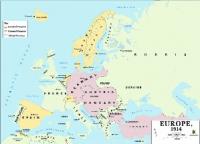‘Strategic ambiguity’
Published in 20th-century / Contemporary History, Features, Issue 4 (July/August 2011), Volume 19 The years between 1890 and 1907 saw major realignment in the system of European alliances. Briefly put, it resulted in the strategic encirclement of Germany and Austria-Hungary by the Triple Entente of France, Russia and Britain. Although the Triple Entente looked formidable, its military agreements remained ill defined, especially where Britain was concerned. As the German historian Michael Stürmer has written, ‘It was an age of strategic ambiguity’. The Germans felt that sooner or later a general war would break out—and the sooner the better from their perspective, as it was estimated that the Russian army would be fully reorganised by 1917. What was needed was a pretext to go to war. The German high command was supremely confident of beating the French and the Russians. But it was less sure about the British, whom they considered to be the potential Hauptfeind (main enemy). The all-important question in Berlin was: would the British interfere in a general war on the Continent? The Germans knew that Britain had a weak western flank, Ireland, which might be exploited or which might prevent her from entering a Continental war. Ireland increasingly seemed a political powder keg because of the growing Home Rule crisis that pitted nationalists against unionists.
The years between 1890 and 1907 saw major realignment in the system of European alliances. Briefly put, it resulted in the strategic encirclement of Germany and Austria-Hungary by the Triple Entente of France, Russia and Britain. Although the Triple Entente looked formidable, its military agreements remained ill defined, especially where Britain was concerned. As the German historian Michael Stürmer has written, ‘It was an age of strategic ambiguity’. The Germans felt that sooner or later a general war would break out—and the sooner the better from their perspective, as it was estimated that the Russian army would be fully reorganised by 1917. What was needed was a pretext to go to war. The German high command was supremely confident of beating the French and the Russians. But it was less sure about the British, whom they considered to be the potential Hauptfeind (main enemy). The all-important question in Berlin was: would the British interfere in a general war on the Continent? The Germans knew that Britain had a weak western flank, Ireland, which might be exploited or which might prevent her from entering a Continental war. Ireland increasingly seemed a political powder keg because of the growing Home Rule crisis that pitted nationalists against unionists.
















